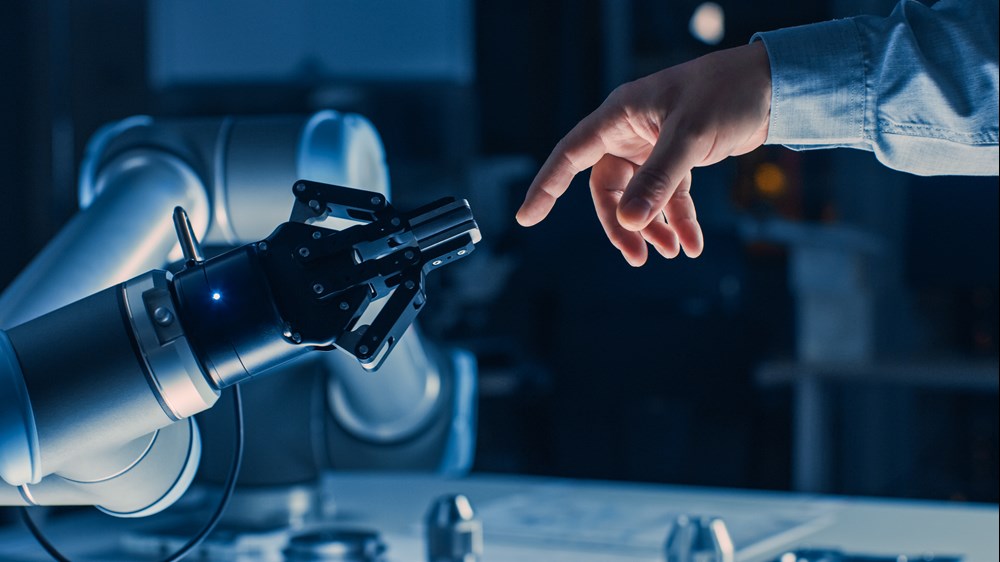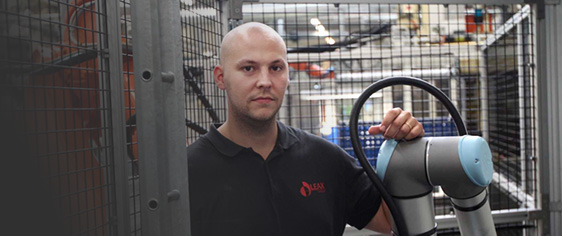Introduction
Robotics technologies have undergone vast advancements in the past few years. As interest in robots by both academia and industries has increased, there has been further encouragement to invest in robotics and to explore the extent to which robots can benefit humans in their day-to-day lives. As a result, while robots were earlier used only to perform repetitive tasks that did not require much effort on humans, they are becoming more intelligent. They have also been able to help humans in various tasks that involve intuition and analysis. The rise of robotic technologies has led to an increase in human-robots and human-robot interaction.
Table of Contents
What Is a Human-Robot?
A human-robot is primarily a robot that has been built to resemble the shape of a human body. Human-robots can be built for experimental, industrial, personal, or academic purposes. The main components of a human-robot are a head, a torso, two arms, and two legs. However, some of them are built from just the waist up or built as individual, stand-alone parts of human anatomy such as a robotic arm. Several detailed human-robots have intricately designed anatomy, but others have a placeholder head wherein most of the functional tasks are accomplished by the limbs.
Sensors are perhaps the essential part of a human-robot. The sensors used in a human robot are also typically more sensitive than those used in an industrial robot. For example, proprioceptive sensors are used to measure the location, speed, and orientation of the joints and parts of a human-robot. Similarly, exteroceptive sensors represent the sense organs in a humanoid robot and are used to determine what has been touched by a robot, what the robot sees, or what the robot hears.
Over the years, human-robots became increasingly popularised in the field of robots. In literature, several different writers have described their fantasies of robots which have uncanny similarities to humans. There have been predictions that the type of human-robots described above may facilitate humans in the coming years and that this type of robot will perform the most tasks.
However, the truth of the matter is that human-robots have a long way to go before they can come close to facilitating humans. They are still wandering around the proverbial ‘uncanny valley,’ in which they come to be considered as something more than a conventional robot but also lesser than a human. Several different research groups and companies have been researching the capabilities of robots to enter into the realm of humanism, but success seems to be lying a few years ahead from now.
What Is Human-Robot Interaction (HRI)?
Simply put, human-robot interaction in the field of robotics deals with the interaction between humans and robots. There are several aspects to human-robot interaction, including the interactions between humans and computers, artificial intelligence, natural language processing, design, robotics, and psychology.
Interestingly, HRI is a field of study that is much older than the field of robotics itself. HRI is known to have close associations with thinking and human communication. Humans have been studying HRI ever since the advent of robots. The fundamentals of human-robot interaction are reflected in Isaac Asimov’s “Three Laws of Robotics,” stating that a robot cannot injure a human or allow one to come in harm’s way, must obey all orders except ones that indicate that it must do so, and must protect itself as long as the previous two laws are not broken by doing so.
Robots were originally to be used in the industrial context and continue to be used in various industries. However, over the past years, the use of robots has also increased in search and rescue, bomb detection, research, law enforcement, and hospital care. These fields require a much greater interaction with human beings. Humans and robots will have a shared workspace and a common motive in working in that workspace in several cases.
With the development of human-like robots increasing and their applications coming close to actual human tasks, this interaction will only increase in the future. There is a need for mutually beneficial interaction between robots and humans and communication that is appropriate and socially correct. These are themes that the field of HRI explores.
HRI spans many different research topics. A major topic is how robots must perceive humans and communicate with them. Another topic explores the coordination between humans and robots carrying out complementary tasks. HRI does not just apply to humanoid robots but also other robots with physical or other interactions with humans.
How Does a Human-Robot Work?
The human-robot is similar to that of a conventional robot in aspects, namely sensor systems, actuators, planning, and control. However, one additional aspect of a human-robot is artificial intelligence.
The sensors used in a human-robot have been covered in the previous section. The speed, orientation, and location-based data of a human-robot are collected using proprioceptive sensors. These are similar to the sensors in our body that help us maintain balance and orientation. The exteroceptive sensors of a human-robot are its sense-organic analogues. These include sensors of vision, sound, and touch.
The motion of a robot is controlled through actuators. Given the complexity of human-robots, several different actuators are incorporated into their various parts. Since motion is a significant part of its functionality, human-robots use many rotary sensors. For applications that require low speed and high load, hydraulic sensors can be helpful. On the other hand, electric sensors are used for high-speed and low-load applications. For the handling of large forces or accurate positioning, piezoelectric sensors are generally used.
The planning and control of a human-robot can be a tricky process since the robot’s movements are expected to be similar to that of a human, such as the simple movements using the joints of its two legs. While this is an easy and intuitive task for us humans, it requires applying major concepts of dynamics and control for robots. Another aspect of planning and control of human-robots is that they interact with a higher number of complex environments than industrial robots. They can potentially be in new environments all the time, which would require them to be aware of their surroundings through sensors and learn from the exposure.
Finally, these robots act as artificial intelligence robot humans. They are continuously collecting and interpreting data from their surroundings thus, learning every single step of the way. A significant aspect of an artificial intelligence robot-human is that it must analyse the data that it collects and base its future actions based on this data.
Applications of Human-Robots
The human-robot market is expected to reach a valuation of nearly 4 billion USD by 2023. This demand for human-robots has been increasing and is speculated to continue rising in the coming years. Here are the major domains in which human-robots can be of use.
- Protection and Safety: In mines, power plants, and other locations where safety is a significant consideration, humanoid robots have been facilitating humans. For example, in defence, humanoid robots can be used to detect mines and even as proxy soldiers at posts. Human-robots can assist humans in disaster response as well.
- Healthcare: Human-robots have been used to assist in treating diseases such as cerebral palsy and pediatric cancer. They are used to interact with patients and to continuously monitor and help provide relief among distressed patients. Human-robots are also used in psychotherapy.
- Education: Human-robots are also seen to play a role in virtual education owing to their virtue of being more engaging and interactive. While human-robots are currently used as an assistant to a human teacher, they may be used as an aid in the future.
- Social Assistance: Human-robots can be used for social assistance for the elderly and those living alone or in retirement or old age homes. They can help older adults with what they do in their day-to-day life and make their lives easier.
About Universal Robots
While human robots are an application of robotics that is likely to gain prevalence in the coming years, we need to take steps toward enabling such technology through advancements in current robotics applications. One such application is the extremely useful robotic arm, used across the world in manufacturing and other technical fields. Universal Robots is a company in the industrial automation domain that manufactures cobots and robotic arms that can be used in all of the fields mentioned in the article. The robotic arms manufactured by Universal Robots are highly flexible, versatile, and easy to program.
FAQs
1. What are the advantages and disadvantages of robots replacing humans?
The advantages and disadvantages of automation through robots have been well documented. Here are some of them.
Advantages
- Robotic automation is cost-effective in the long run because robots can function through nights, on holidays, and on weekends.
- The quality of products developed by the robots is better than those produced by humans as they are accurate and free from any form of human error.
- Robots do not suffer from fatigue and are hence, much more productive and continue to work efficiently over long periods than humans.
Disadvantages
- The initial investment cost can be high and can often go beyond the budget of small and medium-sized companies.
- It is difficult to program robots without expertise in the field; hence, companies are required to train and upskill the staff who operate these robots.
2. Can robots have feelings?
The literature on robots having the same feelings as those of humans is mixed. Robots can be programmed to detect human emotions and to respond in a particular manner, which makes one think that robots can have feelings of their own as well.
However, in reality, it is not what it may seem to be. Robots learn what humans make them learn through programming. We have acquired numerous experiences over the course of our lifetime, and it is highly debatable as to how easily these experiences can be transmitted to robots. How every human responds to a situation is different, and it is hard to fathom how a robot will react emotionally. In any case, such a possibility could only take shape decades from now.
Human-robot interaction will be one of the most important themes in robotics in the coming years because the need for communication between humans and robots has been increasing over the years. In healthcare and social assistance, robots have been helping elderly and differently-abled people carry out their daily activities effectively. Further advances in HRI are bound to improve their efficiency and make them faithful companions to humans. Similarly, as research in HRI reaches new frontiers and impacts the field of education, children will be able to reap the benefits of advanced education through a new type of teaching.
3. What are the advantages of HRI?
Human-robot interaction will be one of the most important themes in robotics in the coming years because the need for communication between humans and robots has been increasing over the years. In healthcare and social assistance, robots have been helping elderly and differently-abled people carry out their daily activities effectively. Further advances in HRI are bound to improve their efficiency and make them faithful companions to humans. Similarly, as research in HRI reaches new frontiers and impacts the field of education, children will be able to reap the benefits of advanced education through a new type of teaching.






